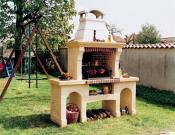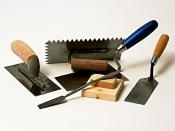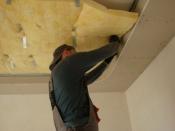Search
Login
Cleaning and disinfecting ventilation systems in a private house
With the development of civilization, people spend more and more time in enclosed spaces, the climate in which is established by ventilation and air conditioning systems. Therefore, it is especially important to monitor the smooth operation of the air supply system and the cleanliness of the filters.
Timely cleaning and disinfection of the lungs at home will save a person from the occurrence of many diseases, increase the productivity and service life of the ventilation system.
Content
- Private house ventilation systems: natural and forced video
- The importance of cleaning and disinfecting the ventilation system
- Organization of work on cleaning the ventilation system
- DIY ventilation and air conditioning systems
- Ventilation system disinfection
Private house ventilation systems: natural and forced
Previously, when houses were built of wood, logs and not plastered from the inside, it was quite possible to do without a ventilation system. Since the air came through the ends of the logs, window and door slots, and the outflow through the chimney of the stove, which was necessarily in any house. The so-called natural ventilation.

Today, this type of ventilation is quite applicable in small wooden country houses with a fireplace or stove.

If the house has a frame structure and is equipped with sealed double-glazed windows, it is necessary to take additional care of the influx of fresh air and the removal of stale.
Natural air flow is carried out in several ways:
- Through leaks in door and window openings. More often this happens in houses with wooden frames. Such an influx of air is enough for a comfortable stay of a person in the house, if the area of \u200b\u200bthe room is not more than 140 sq.m.
- Air supply during window micro-ventilation.

- Airing through a window leaf or opening the frame of a metal-plastic window. In this case, significant heat loss occurs, and for a complete exchange of air, 30-75 minutes are required.
- Ventilation by opening the front door and windows. Air exchange is as quick as possible (2-4 minutes), but a draft can be dangerous for the health of people in the house.

In order to increase the flow of fresh air without resorting to ventilation, it is possible to install inlet wall or window valves.
The technology for the production and installation of metal-plastic windows does not require that any gaps or leaks remain, and the air permeability of the windows is practically zero. Thus, there is no natural influx. To solve this problem, you can choose window units with a built-in supply valve.
If the windows are already installed, then you can mount the wall inlet valve. The position of the valve grill is adjustable: from full opening to completely shut off the air supply. It is better to place the valve near a window (you can hide it behind a curtain) or near a radiator (air entering will heat up).

Valves should be installed in clean areas (bedroom, hall, nursery), to comply with the direction of air flow.
If excess humidity, condensation appears on the windows and molds appear on the walls, this may indicate that the natural ventilation does not perform properly in order to remove contaminated air and excess moisture from the room.
To improve the operation of the ventilation system in a private house, fans and hoods are installed that are suitable for intensive, but short-term ventilation of the room.

The fan and filters significantly reduce the natural draft in the ventilation duct
Central ventilation alternative forced supply and exhaust system with heat recovery.

The system includes:
- ventilation unit with recuperator (heat exchanger);
- air ducts (supply, exhaust);
- filters
- deflector;
- control device.
Air from the street through the fan unit enters the house, and polluted air is discharged through the deflector mounted on the roof. In winter, two streams of air (cold from the street and warm from the house) are found in the recuperator, but do not mix. The air from the street is heated by the outgoing warm air, and enters the room.
Using heat recuperators reduces home heating costs by up to 25%
The forced ventilation system is indispensable for frame houses in which walls, ceilings and floors are sealed with a vapor-tight film.
The importance of cleaning and disinfecting the ventilation system
In order for the house to be not only pleasant, but also useful, all the parameters of the air environment (humidity, temperature, air exchange rate) should be normal. This is greatly facilitated by the timely cleaning of the ventilation and air conditioning systems.

Cleaning the ventilation will help to avoid the negative consequences associated with the contamination of air ducts and filters:
- the growth of mold, fungi and the appearance of other microflora harmful to humans;
- in case of high dustiness of the enclosed space, the risk of fire increases;
- useful duct section is reduced;
- equipment may fail due to increased load.

In parallel with the cleaning of the ventilation system, its disinfection is also carried out; surface disinfection of equipment and reduction of the number of pathogenic microorganisms.

Disinfection of ventilation systems can prevent the multiplication of Staphylococcus aureus, Coca bacillus (causes pulmonary tuberculosis), bacteria that provoke the development of other diseases.
Ventilation disinfection measures are necessary for conducting in kindergartens, schools, catering places, hospitals. The frequency of disinfection once every six months.
In private homes, it is possible to disinfect ventilation ducts less often than cleaning up accumulated dust, dirt and grease.
Organization of work on cleaning the ventilation system
timing for cleaning the ventilation system
There are no written and approved standards for the timing of cleaning ventilation systems for private homes. However, you can focus on the requirements of sanitary services for public and administrative buildings, according to which ventilation systems should be cleaned every six months.

A sign that the ventilation system is contaminated is a decrease or absence of a draft that previously occurred when opening entrance doors or windows.
The need to clean the ventilation duct can be established by bringing a lit match to the ventilation hole. This should be done very carefully, because if a lot of cobwebs have accumulated in the mine shaft, a fire can occur.

If the match flame dies or tends toward the duct, the ventilation is not clogged and functions normally. If it burns with an even flame, then the ventilation is clogged and needs to be cleaned.
equipment and methods for cleaning ventilation
To clean ventilation systems, they use both the old proven method using the standard set of three tools and modern equipment (flexible shafts with rotating brushes).
The three is a set of rope, ruff and ball. This method of cleaning can be used in everyday life, for cleaning straight-through vertical ducts.

A more modern method of cleaning involves the use of specialized equipment.
Among them, the most popular can be distinguished:
- Pneumatic brushing machines. The equipment is designed for round and rectangular ducts. Some models are equipped with a reagent hose and spray nozzles, which allows the use of machines to disinfect the ventilation system. Often used to remove grease from the inside of ducts.
- Flexible shaft. It is convenient for cleaning ventilation ducts of a small section, with a diameter of up to 300 mm. Work can be performed both from top to bottom and from bottom to top. The brush must be included in the cleaning kit, and the drill with revolutions of at least 900 serves as the drive for the flexible shaft.

- Vacuum type plants this is equipment in which the ventilation system is cleaned under high negative pressure. The unit is equipped with a powerful engine and a filter with a high degree of purification. It is used in long ducts and eliminates many contaminants (dust, quartz, mineral wool, sawdust, asbestos, microorganisms, fungal spores and mold).

- The degree of contamination of the system can be determined using equipment for video inspection. Very high quality video materials are displayed on the monitor screen, according to which it is possible to establish not only the pollution of the ventilation, but also possible malfunctions and slightest damage to the walls of the duct.

- Air conditioners can be cleaned with special steam cleaners that effectively cope with dirt particles on the radiator plates, the fan and the external unit of the split system.

DIY ventilation and air conditioning systems
ventilation duct cleaning
Cleaning the air ducts of the ventilation system is not a simple process, but it is feasible. First you need to remove the grille of the ventilation duct and remove contaminants that are in the reach. You can use a vacuum cleaner with a brush or a brush.

If the ventilation duct is straight and not too long, you can clean it with a vacuum cleaner with a brush. Care must be taken so that the nozzle does not fall into the duct, otherwise it will be problematic to get it.
If the ventilation system provides for filters, they must be removed and also cleaned with an ordinary vacuum cleaner.
Vertical ventilation ducts can be cleaned with a triple by attaching a ruff and a weighting ball to the rope.
air conditioning cleaning
The following precursors for cleaning air conditioners can be distinguished:
- unpleasant odor indicates the growth of mold and fungi in the drainage system and the condensate receiver;
- dripping water from the indoor unit of the air conditioner drainage pipe clogged;
- the operation of the system is accompanied by noise and crackling. The radiator is dirty.

Consider phasing out the air conditioner:
- Remove the front panel of the indoor unit. The instructions for the air conditioner should describe how to do this correctly.
- It is necessary to remove the filters from the unit, lifting them by the lower part of the frame.
- Clean the filter with a damp cloth or under running water. If there are greasy contaminants, they can be removed with liquid soap or dishwashing detergent.
- The radiator of the air conditioner can be flushed with an antiseptic from a syringe. To do this, pour an antiseptic from the syringe onto the surface of the radiator and turn on the air conditioner for 15 minutes. During this time, the antiseptic, mixed with condensate, will clean up inaccessible places in the pipeline.
- After drying, the filter can be replaced.
You can also clean the air conditioner with a steam cleaner.
kitchen hood cleaning
Kitchen exhaust ventilation needs to be cleaned more often, as it gets dirty faster.

Cleaning the hood includes the following steps:
- Disconnect the hood from the power supply.
- Disassemble the device according to the instructions (remove the strainer).
- Clean the filter. To do this, you can heat the water in a large pan and add chopped (grated) laundry soap and soda to it. After boiling the solution, the mesh must be left in water for several hours.
- The cleaned mesh must be rinsed in running water.
- The hood must also be cleaned (with a damp cloth dampened in soapy water).
- Replace the mesh.
Ventilation system disinfection
disinfecting procedures
If the ventilation can be cleaned independently, then it is better to entrust disinfection to professionals. Since there are a number of requirements for disinfection and storage of special products that are difficult to adhere to at home.

Key requirements include:
- for disinfection of ventilation and air conditioning systems, it is necessary to use only funds that have passed state registration;
- persons carrying out disinfection measures are required to undergo special training;
- equipment and devices must comply with the disinfectant solution and the tasks;
- complete disinfection of air ducts is carried out according to epidemiological indications;
- preventive disinfection of air conditioners and ventilation is desirable to be carried out once a quarter with a complete shutdown of systems.
disinfection precautions
Persons involved in the disinfection of the ventilation system must be instructed and adhere to the basic safety rules:
- avoid disinfectant solution in the eyes and skin;
- hands should be protected with rubber gloves, eyes with glasses, and the respiratory system with a respirator;
- at the end of work, wash your hands with soap;
- drugs should be in a metal cabinet under lock and key (room temperature not more than 20 degrees);
- in case of contact with skin or eyes, rinse thoroughly with water for about 10 minutes; consult a doctor if necessary.

Timely cleaning and disinfection of ventilation systems will be the key to clean, fresh air entering the house.





